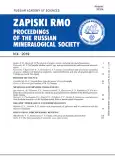Nature of diversity of diamonds in kimberlites
- Authors: Shkodzinskiy V.S.1, Beskrovanov V.V.2
-
Affiliations:
- Diamond and Precious Metal Geology Institute of Siberian Branch Russian Academy of Sciences
- North-Eastern Federal University named after M.K. Ammosov
- Issue: Vol 148, No 4 (2019)
- Pages: 110-124
- Section: ДИСКУССИИ, КРИТИКА, БИБЛИОГРАФИЯ
- URL: https://journals.eco-vector.com/0869-6055/article/view/11878
- DOI: https://doi.org/10.30695/zrmo/2019.1484.08
- ID: 11878
Cite item
Abstract
The one-way evolution of inclusions in diamonds and its ultra-long duration (more than 2.8 Ga) provide evidence that the crystallization of diamonds took place from the fractionated peridotitic layer in the global magmatic ocean. Diamonds were formed as a result of accumulation of carbon in residual kimberlitic melts. The increment of SiO2 concentration in the melts caused increase in its viscosity, decrease of diffusion velocity and degree of carbon oversaturation. These resulted that the layered diamond crystallization mode was changed by the radial one, diamond octahedrons transformed into rhombic dodecahedrons and cubes, varied sculptures were created on diamond crystals faces.
Keywords
Full Text
About the authors
Vladimir S. Shkodzinskiy
Diamond and Precious Metal Geology Institute of Siberian Branch Russian Academy of Sciences
Author for correspondence.
Email: shkodzinskiy@diamond.ysn.ru
ORCID iD: 0000-0001-7749-1264
SPIN-code: 7797-7586
doctor of geology, research worker
Russian Federation, 677000, Yakutsk, Lenin st. 39Viktor V. Beskrovanov
North-Eastern Federal University named after M.K. Ammosov
Email: vv.beskrovanov@s-vfu.ru
doctor of geology, professor
Russian Federation, Yakutsk, Kulakovskogo st., 48References
- Argunov K. P. Defective diamonds and their diagnostics. Yakutsk: SB RAS, 2004. 216 p. (in Russian).
- Argunov K. P. Yakutia diamonds. Novosibirsk: SB RAS, 2005. 402 p. (in Russian).
- Aulbach S., Stachel T., Heanman L. M., Creaser R. A., Seitz H. M., Shirey S. B. Diamond formation in the slab and mantle wedge: examples from the slave craton. In: 10th Int. Kimberlite Conf. Extend. Abstr. 2012. N 101KC-038.
- Beskrovanov V. V. Diamond ontogeny. Novosibirsk: SB RAS, 2000. 264 p. (in Russian).
- Boyd F. R., Gurney J. J. Diamonds and the African lithosphere. Science. 1986. Vol. 323. P. 472-477.
- Bulanova G. P. Formation of diamond. J. Geochem. Explor. 1995. Vol. 53. P. 1-23.
- Grahanov S. A., Shatalov V. I., Shtyrov V. A., Kichkin V. R., Suleimanov A. M. Diamond placers of Russia. Novosibirsk: SB RAS, 2000. 457 p. (in Russian).
- Haidarov A. A., Gafitdulina K. P., Argunov K. P. Nucler-physical methods of control diamonds. Tashkent: FAN, 1986. 160 p. (in Russian).
- Haggerty S. E. Diamond genesis in a multiply constrained model. Nature. 1986. Vol. 320. P. 34-38.
- Malkovets V., Zedgenizov D., Dak A. I., Griffin W., OʼReilly S. Y., Pokhilenko N. P., Mityukhin S. I. Diamondiferous microxenoliths and xenocrysts from Nyurbinskaya kimberlite pipe, Yakutia. In: 9th Int. Kimberlite Conf. Extend. Abstr. No 91KC-A- 00224, 2008.
- Mysen B. O., Boetcher A. L. Melting of hydrous mantle. I. Phase relations of natural peridotite at high pressure and high temperature with controlled activities of water, carbon dioxide and hydrogen. J. Petrol. 1975. Vol. 16. P. 520-540.
- Orlov Yu. L. Diamond mineralogy. Moscow: Nauka, 1973. 223 p. (in Russian).
- Persikov E. S. Viscosity of magmatic melts. Moscow: Nauka, 1984. 160 p. (in Russian).
- Ragosin A. L., Shazkiy V. S. Mineralogy and genesis round diamonds from placers of North-East of the Siberian platform. In: Problems of deposit prediction, prospecting, and study in start of XXI century. Ed. N. N. Zinchuk, A. D. Savko. Voroneg: VGU, 2003. P. 245-249 (in Russian).
- Ringwood A. E. Origin of the Earth and Moon. New York, Heidelberg, Berlin: Springer-Verlag. 1979. 294 р.
- Rusmaikina T. V. Protoplanetary disk - from idea of capture to theory of genesis. Physics of the Earth. 1991. N 8. P. 5-14 (in Russian).
- Shkodzinskiy V. S. Genesis of lithosphere and diamonds. Model of hot heterogenous accretion of the Earth. Saarbrücken: Palmarium academic publishing, 2015. 687 p. (in Russian).
- Shkodzinskiy V. S. Global petrology according to modern data on hot heterogenous accretion of the Earth. Yakutsk: Publisher SVFU, 2018. 244 p. (in Russian).
- Spetsius Z. V., Kovalchuck O. E., Bogush I. N. Properties of diamonds in xenoliths from kimberlites of Yakutia: implication to their origin and exploration. In: 10th Int. Kimberlite Conf. Extend. Abstr. 2012. N 101KC-51.
- Sunagava I. Materials science of the Earthʼs interior. Tokio, 1984. 654 p.
- Wyllie P. J., Huang W. L. Carbonation and melting reactions in the system CaO-MgO-SiO2-CO2 at mantle pressure with geophysical and petrological applications. Contr. Miner. Petrol. 1976. Vol. 54. N 2. P. 79-107.
- Zedgenisov D. A., Araujo D., Ragozin A. L., et al. Carbonatite to hydroussilic growth medium of diamonds from International kimberlite pipe (Yakutia). In: 9th International Kimberlite Conference. Extended Abstract. 2009. N 91KCA00108.
- Zhang Z., Fedortchouk Y. Mantle-derived morphologies of diamond: records diamond-destroyng mantle metasomatism. In: 10th Int. Kimberlite Conf. Extend. Abstr. 2012. N 101KC-095.
Supplementary files














